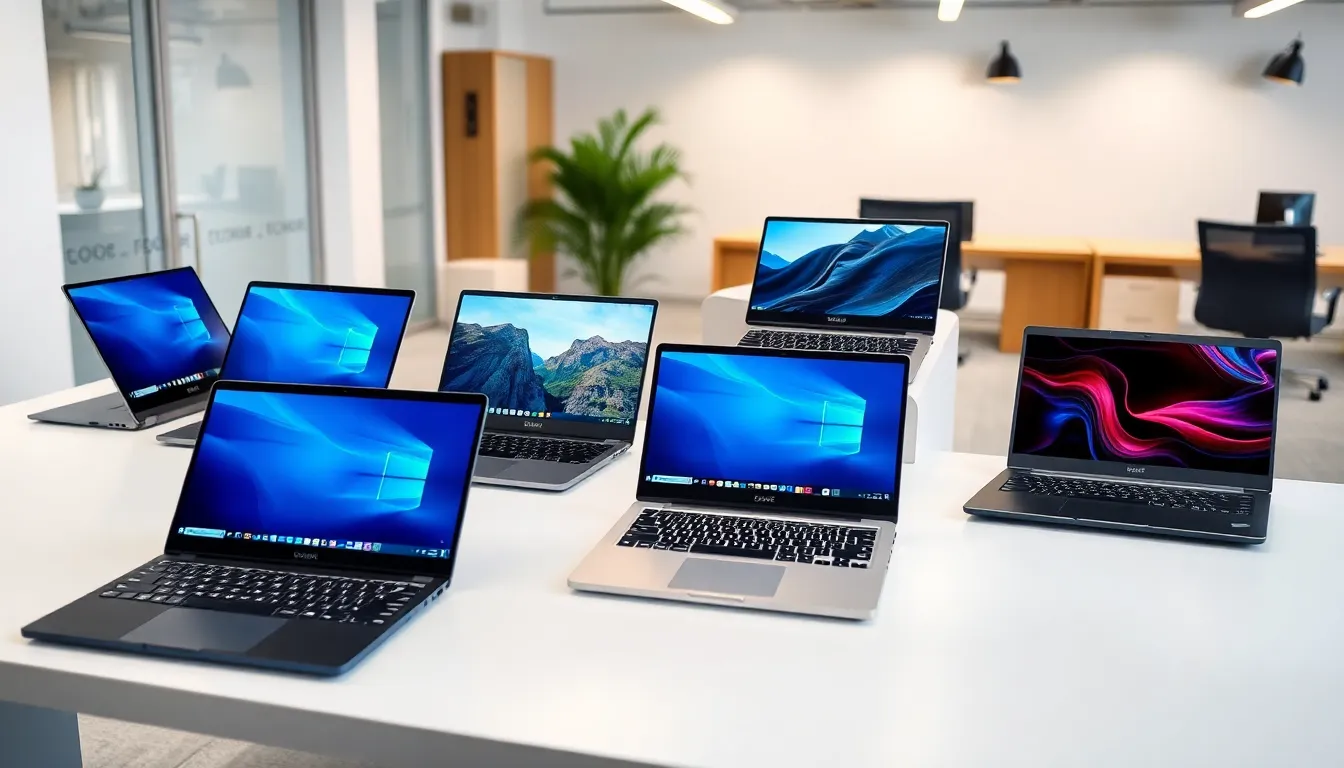Table of Contents
ToggleIn today’s fast-paced world, the weight of a laptop can significantly impact a user’s experience. Whether commuting to work, traveling for leisure, or simply moving from room to room, a lightweight laptop offers unparalleled convenience and portability. As technology evolves, manufacturers are constantly striving to balance performance with weight, leading to a diverse range of options for consumers.
Understanding the importance of laptop weight goes beyond mere convenience; it influences productivity and comfort. A lighter device can make long hours of use more manageable, while heavier models might be better suited for those who prioritize power over portability. This article delves into the factors that affect laptop weight, helping readers make informed decisions in choosing the right device for their needs.
Understanding Laptop Weight
Laptop weight plays a crucial role in the user experience, especially for individuals who frequently travel or commute. This section examines the importance of laptop weight and the various factors that influence it.
Importance of Laptop Weight
Laptop weight significantly affects portability and convenience. Lighter devices enhance mobility, allowing users to carry them effortlessly during commutes or trips. Studies indicate that laptops weighing under 4 pounds cater to a wider range of users who prioritize portability over raw power. Additionally, lighter laptops reduce fatigue during extended use, which is essential for professionals and students alike. Heavier models often provide enhanced performance and durability, appealing to users favoring power-centric tasks such as gaming and graphic design.
Factors Influencing Laptop Weight
Several factors contribute to the overall weight of a laptop:
- Materials Used: Manufacturers utilize various materials, such as aluminum, magnesium, and plastics. Aluminum models often weigh less but maintain strength, while plastic versions may be lighter but less durable.
- Components: The choice of internal components, like processors, GPUs, and batteries, affects weight. High-performance components typically add weight, whereas energy-efficient components allow for lighter designs.
- Screen Size: Larger screens translate to increased weight. Many lightweight models feature displays between 13 and 14 inches to balance portability and functionality.
- Design and Form Factor: Ultrabooks and convertible laptops prioritize slim profiles and light materials. Traditional laptops may have additional features, such as robust cooling systems, contributing to increased weight.
- Battery Size: Battery capacities vary, impacting weight. Larger batteries extend battery life but add bulk, while smaller batteries can reduce weight but may compromise user experience in terms of longevity.
Types of Laptop Weights

Different types of laptops cater to various needs, and understanding their weight categories helps consumers make informed choices. Below are the primary classifications based on weight.
Ultralight Laptops
Ultralight laptops typically weigh under 3 pounds. These models prioritize portability and convenience, making them ideal for frequent travelers and commuters. Ultralight laptops often feature slim profiles and energy-efficient components, sacrificing some performance for enhanced mobility. Notable examples include the Dell XPS 13 and the ASUS ZenBook series.
Standard Laptops
Standard laptops range from 3 to 5 pounds, combining a balance of performance and portability. Users seeking a reliable device for everyday tasks often prefer this category. Standard laptops usually offer sufficient processing power and screen size while remaining manageable for transport. Popular choices include the HP Pavilion and Lenovo ThinkPad series.
Gaming Laptops
Gaming laptops usually exceed 5 pounds due to their advanced hardware and larger batteries. These models often include high-performance GPUs, extensive cooling systems, and robust build quality to handle demanding tasks. Their weight is justified by the need for powerful gaming capabilities and performance, appealing to enthusiasts and professionals. Examples include the Alienware m15 and the Razer Blade series.
2-in-1 Laptops
2-in-1 laptops, or convertible devices, typically weigh between 3 to 4.5 pounds. Their design allows for versatile functionality, functioning as both laptops and tablets. While they emphasize flexibility, these models maintain satisfactory performance for tasks such as browsing and productivity. Notable models include the Microsoft Surface Pro and the Lenovo Yoga series.
Impact of Laptop Weight on Use
Laptop weight significantly influences user experience, particularly in terms of portability and performance. Understanding the ramifications of weight helps consumers choose devices that suit their needs.
Portability and Travel Considerations
Weight directly correlates with portability, making lighter laptops preferable for travelers. Laptops weighing under 4 pounds enhance mobility, allowing users to carry them effortlessly during commutes or trips. Frequent travelers favor ultralight laptops, as they reduce overall luggage weight and fatigue during long journeys. A laptop under 3 pounds maximizes convenience for those moving between locations. Lighter models typically feature compact designs, contributing to ease of transport while still providing essential functionality.
Performance vs. Weight Trade-offs
Balancing performance and weight presents a challenge for both manufacturers and consumers. Lighter laptops generally utilize less powerful components to minimize bulk, resulting in moderate performance levels. Users engaged in resource-intensive tasks, such as gaming or video editing, may require heavier models equipped with advanced hardware. These machines often weigh over 5 pounds but deliver superior performance. Therefore, buyers must assess their specific needs, determining whether they prioritize portability or require higher performance capabilities. Users focused on versatile computing may opt for 2-in-1 devices, weighing between 3 and 4.5 pounds, offering a balance between functionality and weight.
Tips for Choosing the Right Laptop Weight
Selecting the right laptop weight involves understanding personal needs and usage scenarios. The following tips help buyers make informed decisions.
Best Practices for Assessing Weight
- Identify Usage Patterns: Determine primary activities, such as commuting or gaming. Mobile users prefer lightweight models, while power users often trade off weight for performance.
- Consider Carry Method: Assess how a laptop will be transported. Users with briefcases or backpacks may favor lighter options, while stationary setups may tolerate heavier devices.
- Evaluate Comfort: Test holding and carrying potential laptops. Models that feel more balanced and comfortable during prolonged usage are preferable.
- Research Material Quality: Understand how materials impact weight and durability. Aluminum shells provide a good strength-to-weight ratio compared to heavier plastics.
- Examine Battery Size: Analyze how battery capacity affects weight. Greater battery life often leads to heavier devices, which may not meet portability needs.
Recommended Weight Ranges for Different Users
| User Type | Recommended Weight Range |
|---|---|
| Frequent Travelers | Under 3 pounds |
| Business Professionals | 3 to 4.5 pounds |
| Everyday Users | 3 to 5 pounds |
| Gamers and Creators | 5 pounds and above |
| Versatile Users | 3 to 4.5 pounds |
- Frequent Travelers: Models under 3 pounds are ideal due to easy portability.
- Business Professionals: Laptops weighing between 3 and 4.5 pounds balance performance with mobility.
- Everyday Users: Weight ranging from 3 to 5 pounds suits general tasks and occasional travel.
- Gamers and Creators: Devices exceeding 5 pounds cater to users seeking top-tier performance for demanding software.
- Versatile Users: Models between 3 and 4.5 pounds serve dual purposes effectively for both productivity and casual use.
Making the right choice regarding laptop weight hinges on understanding personal priorities and usage needs.
Choosing the right laptop weight is crucial for enhancing user experience. It’s essential for individuals to evaluate their specific needs and how they intend to use their device. Lighter laptops offer unmatched portability making them ideal for frequent travelers while heavier models provide the power needed for demanding tasks.
By understanding the trade-offs between weight and performance users can make informed decisions that align with their lifestyle. Whether prioritizing mobility or power it’s clear that a thoughtful approach to selecting laptop weight can significantly impact productivity and comfort.







